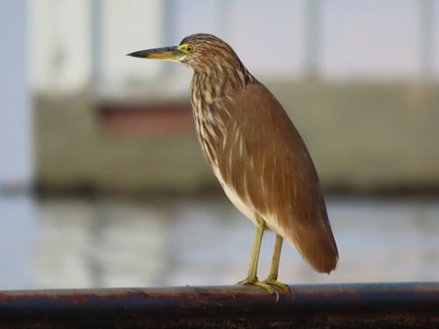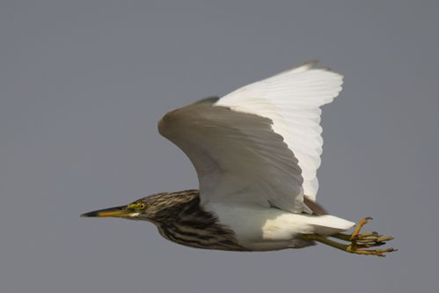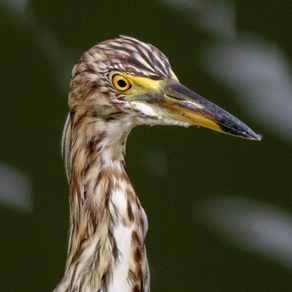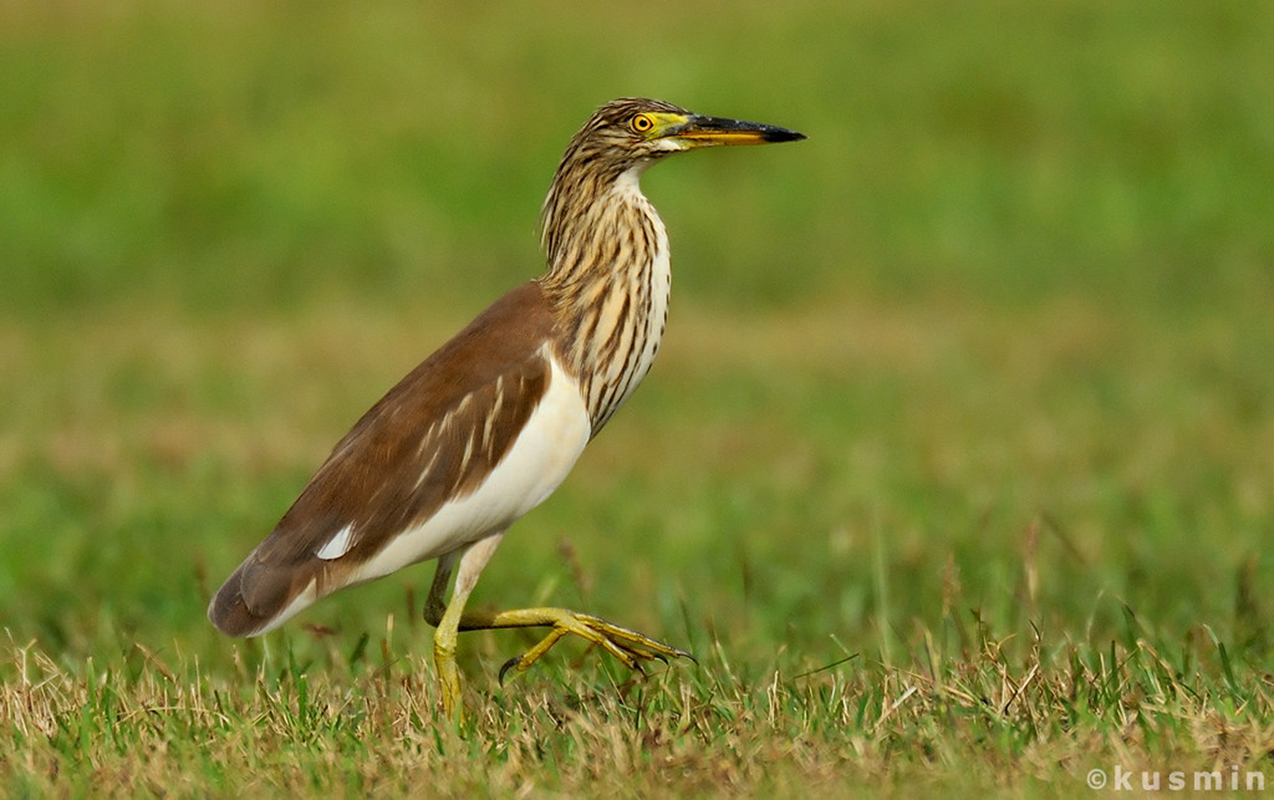ເລກລຳດັບທີ: 3832
ລະດັບການຮວບຮວມຂໍ້ມູນ: ເກີອບສົມບູນ
ປັບປູງຄັ້ງລ່າສຸດ: 2024-10-17
ນົກເຈົ່ານາ
Chinese pond heron
Ardeola bacchus (Bonaparte, 1855)
ສັດ
ສັດປີກ
×
ຊື່ທ້ອງຖີ່ນ:
ນົກເຈົ່າ
ຊື່ພ້ອງ
:
Buphus bacchus Bonaparte, 1855
ຊື່ສະກຸນ:
Ardeidae
ຊະນິດໃກ້ຄຽງ:
ນົກເຈົ່າໝໍ້/ black bittern
ນົກເຈົ່າຟານ/ cinnamon bittern
ນົກເຈົ່າຟານ/ cinnamon bittern
ບັນຍາຍລັກສະນະທາງພືດສາດ:
ຂະໜາດຂອງລຳຕົວຍາວ 45 ຫາ 52 ຊມ. ໃຫ່ຍເຕັມໄວນອກລະດູປະສົມພັນ ຈະບໍ່ມີຄຳອະທິບາຍພຶດຕິກຳໃນຂະນະທີ່ຢູ່ຊື່ໆ ແຕ່ເມື່ອບິນ ຫາງ ແລະ ປີກຈະເປັນສີຂາວ, ຕັ້ງແຕ່ຫົວຮອດເອິກມີສີເຫຼືອງອອ່ນເປັນສ່ວນຫລາຍ, ມີແຖບສີນ້ຳຕານເຂັ້ມ, ໜາ ແລະ ຍາວ, ໄຫຼ່ ແລະ ຂົນໂຄນປີກເປັນສີນ້ຳຕານປົນສີເຫຼືອງອົມຂຽວ, ຂົນສ່ວນທີ່ເຫຼືອຈະເປັນສີຂາວ. ຮິມຝີປາກເປັນສີແດງ ແລະ ມີປາກເປັນສີເຂັ້ມ (ອາດມີສີເຂັ້ມກ່ວາຮິມຝີປາກດ້ານເທິງ). ຂາ ແລະ ຕີນເປັນສີເຫຼືອງປົນຂຽວ ຫາງສີເຫຼືອງ ແຕ່ບາງຄັ້ງຈະເຫັນວ່າປາຍຂົນມີສີເຂັ້ມຂື້ນຈົນຮອດປາຍປີກດ້ານນອກສຸດ ເມື່ອທຽບກັບນົກຊາວາ. ໃຫ່ຍເຕັມໄວໃນລະດູປະສົມພັນ ໜ້າເອິກ, ຄໍ ແລະ ຫົວ ຈະເປັນສີນ້ຳຕານໄໝ້, ດ້ານໜ້າຄໍເປັນສີຂາວ, ຂົນບໍລິເວນໂຄນປີກ ແລະ ໄຫຼ່ເປັນສີເທົາ ຫາ ສີດຳ. [6]
ພຶດຕິກຳ: ມັກອອກຫາກິນຕາມບໍລິເວນເປີດໂລງກາງແຈ້ງ ເຊັ່ນ: ທົ່ງນາ, ໜອງ, ບຶງ, ໂດຍທົ່ວໄປມັກຈະຢູ່ຊື່ໆໃນຂະນະທີ່ຊ່ອງຫາປາ, ເມື່ອພັກຜ່ອນຈະຫົດຄໍເຂົ້າ ແລະ ເມື່ອບິນຈະສົ່ງສຽງຮ້ອງ “ກຣອກ” ດັງ. [3]
ອາຫານ: ກິນສັດນ້ຳຂະໜາດນ້ອຍເປັນອາຫານ ເຊັ່ນ: ຕົວອ່ອນຂອງກຸ້ງ, ລູກປາ, ຕົວອ່ອນຂອງປູ, ຕົວອ່ອນຂອງງູ ແລະ ແມງໄມ້. [3]
ພຶດຕິກຳ: ມັກອອກຫາກິນຕາມບໍລິເວນເປີດໂລງກາງແຈ້ງ ເຊັ່ນ: ທົ່ງນາ, ໜອງ, ບຶງ, ໂດຍທົ່ວໄປມັກຈະຢູ່ຊື່ໆໃນຂະນະທີ່ຊ່ອງຫາປາ, ເມື່ອພັກຜ່ອນຈະຫົດຄໍເຂົ້າ ແລະ ເມື່ອບິນຈະສົ່ງສຽງຮ້ອງ “ກຣອກ” ດັງ. [3]
ອາຫານ: ກິນສັດນ້ຳຂະໜາດນ້ອຍເປັນອາຫານ ເຊັ່ນ: ຕົວອ່ອນຂອງກຸ້ງ, ລູກປາ, ຕົວອ່ອນຂອງປູ, ຕົວອ່ອນຂອງງູ ແລະ ແມງໄມ້. [3]
ນິເວດວິທະຍາ
ເຂດກະຈາຍພັນທົ່ວໂລກ:
Native to Korea, Brunei Darussalam, Cambodia, China, India, Indonesia, Japan, Lao People's Democratic Republic, Malaysia, Myanmar, Philippines, Russian Federation, Singapore, Taiwan, Province of China, Thailand and Viet Nam. [4]
ຊະນິດພັນພື້ນເມືອງຂອງ ເກົາຫຼີ່, ບຣູໄນ, ກຳປູເຈຍ, ຈີນ, ອິນເດຍ, ອິນໂດເນເຊຍ, ຢີປຸ່ນ, ລາວ, ມາເລເຊຍ, ມຽນມາ, ຟີລິບປິນ, ຣັດເຊຍ, ສິງກາໂປ, ໄຕຫວັນ, ໄທ, ຫວຽດນາກ. [4]
Ardeola bacchus distribution between 2004 to 2024. Source: [5]
ເຂດກະຈ່າຍພັນທົ່ວໂລກຂອງນົກເຈົ່າລະຫວ່າງປີ 2004 ຫາ 2024. ແຫຼ່ງທີ່ມາ: [5]
ຊະນິດພັນພື້ນເມືອງຂອງ ເກົາຫຼີ່, ບຣູໄນ, ກຳປູເຈຍ, ຈີນ, ອິນເດຍ, ອິນໂດເນເຊຍ, ຢີປຸ່ນ, ລາວ, ມາເລເຊຍ, ມຽນມາ, ຟີລິບປິນ, ຣັດເຊຍ, ສິງກາໂປ, ໄຕຫວັນ, ໄທ, ຫວຽດນາກ. [4]
Ardeola bacchus distribution between 2004 to 2024. Source: [5]
ເຂດກະຈ່າຍພັນທົ່ວໂລກຂອງນົກເຈົ່າລະຫວ່າງປີ 2004 ຫາ 2024. ແຫຼ່ງທີ່ມາ: [5]
ເຂດກະຈາຍພັນໃນລາວ
:
ເຂດສາຍພູຫຼວງພາກກາງ
ເຂດລຽບແມ່ນ້ຳຂອງພາກໃຕ້
ເຂດພູສູງພາກເໜືອຂອງລາວ
ເຂດພູສູງສາຍພູຫຼວງ ແລະ ເຂດພູພຽງແຂວງຊຽງຂວາງ
ເຂດສາຍພູຫຼວງຕອນລຸ່ມ
ພູພຽງບໍລິເວນ
ທົ່ງພຽງວຽງຈັນ
ລຽບແມ່ນ້ຳຂອງພາກເໜືອ
ເຂດສາຍພູຫຼວງພາກເໜືອ
ເຂດລຽບແມ່ນ້ຳຂອງພາກໃຕ້
ເຂດພູສູງພາກເໜືອຂອງລາວ
ເຂດພູສູງສາຍພູຫຼວງ ແລະ ເຂດພູພຽງແຂວງຊຽງຂວາງ
ເຂດສາຍພູຫຼວງຕອນລຸ່ມ
ພູພຽງບໍລິເວນ
ທົ່ງພຽງວຽງຈັນ
ລຽບແມ່ນ້ຳຂອງພາກເໜືອ
ເຂດສາຍພູຫຼວງພາກເໜືອ

ເຂດກະຈາຍພັນຕາມພູມສັນຖານ
:
ແຄມຝັ່ງນໍ້າ
ທົ່ງຫຍ້າ
ແມ່ນ້ຳ ແລະ ລຳທານ
ໜອງບຶງ ແລະ ດິນຖານຕົມ
ທົ່ງຫຍ້າ
ແມ່ນ້ຳ ແລະ ລຳທານ
ໜອງບຶງ ແລະ ດິນຖານຕົມ
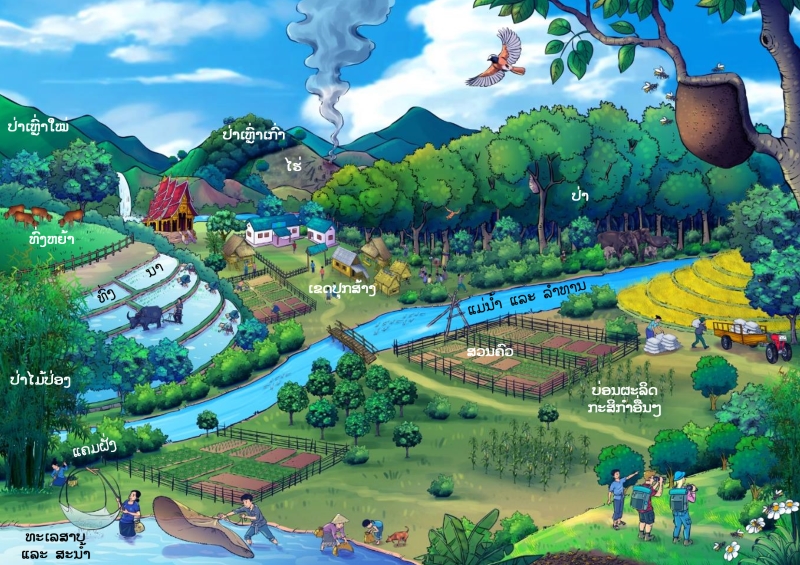
ສະເພາະຖິ່ນໃນລາວ:
ພື້ນເມືອງ
ຮຸກຮານ
:
ບໍ່ຮຸກຮານ
ສະຖານະພາບການອະນູຮັກ IUCN
:
ມີຄວາມສ່ຽງໜ້ອຍສຸດ
ສະຖານະພາບການອະນຸຮັກແຫ່ງຊາດລາວ
:
ບໍ່ຖືກລະບຸໃນບັນຊີປະເພດໃດ
ການນຳໃຊ້
ປະເພດການນຳໃຊ້:
ອາຫານ
ບັນຍາຍການນຳໃຊ້:
ອາຫານ: ຊີ້ນສາມາດນຳມາປະກອບອາຫານໄດ້ຫຼາຍປະເພດ ເຊັ່ນ: ປີ້ງ, ລາບ ແລະ ອື່ນໆ. [4]
ການປູກ ການລ້ຽງ:
ຊະນິດທຳມະຊາດ
ລະດູການເກັບກູ້:
ກັນຍາ
ຕຸລາ
ຕຸລາ
ການຕະຫຼາດ ແລະ ຕ່ອງໂສ້ມູນຄ່າ:
N/A
ການຄຸ້ມຄອງຈັດການ
ການອານຸລັກທີ່ຢູ່ອາໄສ:
ຄາດວ່າຈຳນວນປະຊາກອນຍັງຄົງທີ່ ເນື່ອງຈາກບໍ່ມີລາຍງານການຫຼຸດລົງ ຫຼື ໄພຄຸກຄາມທີ່ສຳຄັນໃດໆ. [1], [4]
ການຕິດຕາມປະຊາກອນ:
ຄາດວ່າຈະມີຈຳນວນປະຊາກອນໂລກປະມານ 25,000 ຫາ 1,000,000 ໂຕ (Wet-lands International 2006) ໃນຂະນະທີ່ຈຳນວນປະຊາກ່ອນແຕ່ລະປະເທດຄາດວ່າມີຈຳນວນປະມານ 10,000 ຫາ 100,000 ຄູ່ປະສົມພັນ ແລະ ປະມານ 1,000 ຫາ 10,000 ໂຕ ທີ່ອົບພະຍົບໄປຈີນ ແລະ ໜ້ອຍກ່ວາ 100 ຄູ່ປະສົມພັນ ແລະ ປະມານ 50 ຫາ 1,000 ໂຕ ອົບພະຍົບໄປເກົາຫຼີ (Brazil 2009). [4]
ຄາດວ່າຈຳນວນປະຊາກອນຍັງຄົງທີ່ ເນື່ອງຈາກບໍ່ມີລາຍງານການຫຼຸດລົງ ຫຼື ໄພຄຸກຄາມທີ່ສຳຄັນໃດໆ. [1], [4]
ການຕິດຕາມປະຊາກອນ:
ຄາດວ່າຈະມີຈຳນວນປະຊາກອນໂລກປະມານ 25,000 ຫາ 1,000,000 ໂຕ (Wet-lands International 2006) ໃນຂະນະທີ່ຈຳນວນປະຊາກ່ອນແຕ່ລະປະເທດຄາດວ່າມີຈຳນວນປະມານ 10,000 ຫາ 100,000 ຄູ່ປະສົມພັນ ແລະ ປະມານ 1,000 ຫາ 10,000 ໂຕ ທີ່ອົບພະຍົບໄປຈີນ ແລະ ໜ້ອຍກ່ວາ 100 ຄູ່ປະສົມພັນ ແລະ ປະມານ 50 ຫາ 1,000 ໂຕ ອົບພະຍົບໄປເກົາຫຼີ (Brazil 2009). [4]
ໂພຊະນາການ
ຄຸນຄ່າທາງໂພຊະນາການ:
ບັນຍາຍຄຸນຄ່າທາງໂພຊະນາການ:
N/A
| ສານອາຫານ | /100g | ໝາຍເຫດ |
|---|---|---|
| ໂປຣຕີນ | N/A | N/A |
| ຄາໂບໄຮເດຣດ | N/A | N/A |
| ໄຂມັນ | N/A | N/A |
| ວິຕາມິນ | N/A | N/A |
| ແຮ່ທາດ | N/A | N/A |
| ເສັ້ນໄຍ | N/A | N/A |
ອ້າງອິງ
ເຄດິດຮູບພາບ:
Chinese Pond Heron. [1] iNaturalist [Online]. Uploaded on 12 January 2024 by: belvedere04. Available: www.inaturalist.org/photos/345769646. [Accessed: 18 September 2024].
Chinese Pond Heron flying. [2] iNaturalist [Online]. Uploaded on 18 January 2024 by: naturalist74450. Available: www.inaturalist.org/photos/347931788. [Accessed: 18 September 2024].
Chinese Pond Heron up close. [3] iNaturalist [Online]. Uploaded on 25 February 2023 by: quillasophink. Available: www.inaturalist.org/photos/263286622. [Accessed: 18 September 2024]
Chinese Pond Heron flying. [2] iNaturalist [Online]. Uploaded on 18 January 2024 by: naturalist74450. Available: www.inaturalist.org/photos/347931788. [Accessed: 18 September 2024].
Chinese Pond Heron up close. [3] iNaturalist [Online]. Uploaded on 25 February 2023 by: quillasophink. Available: www.inaturalist.org/photos/263286622. [Accessed: 18 September 2024]
ອ້າງອິງ:
[1] Thai National Parks, “Chinese Pond Heron” [Online]. Availa-ble: https://www.thainationalparks.com/species/chinese-pond-heron. [Accessed: 18 September 2024]
[2] Global Biodiversity Information Facility (GBIF), “Species: Ar-deola bacchus (Bonaparte, 1855)” [Online]. Available: https://www.gbif.org/species/2480907. [Accessed: 18 September 2024]
[3] Animal, “Animal,” [Online]. Available: https://chiangmai.zoothailand.org/en/animal_view.php?detail_id=95&c_id=. [Accessed: 15 March 2024]
[4] IUCN, “IUCN Red List,” [Online]. Available: https://www.iucnredlist.org/species/22697133/93600684s. [Accessed: 06 March 2024]
[5] Heron Conservation Network, “Chinese Pond Heron,” [Online]. Available: https://www.heronconservation.org/herons-of-the-world/list-of-herons/chinese-pond-heron/#:~:text=Migration%3A%20Northern%20birds%20are%20migratory,Return%20migration%20is%20May%E2%80%93April. [Accessed: 18 September 2024].
[6] Xayyasith, S. (2018). Birds in Hin Nam No National Protected Area. Khaammuane: Deutsche Gesellschaft für Internationale Zusammenarbeit (GIZ) GmbH.
[2] Global Biodiversity Information Facility (GBIF), “Species: Ar-deola bacchus (Bonaparte, 1855)” [Online]. Available: https://www.gbif.org/species/2480907. [Accessed: 18 September 2024]
[3] Animal, “Animal,” [Online]. Available: https://chiangmai.zoothailand.org/en/animal_view.php?detail_id=95&c_id=. [Accessed: 15 March 2024]
[4] IUCN, “IUCN Red List,” [Online]. Available: https://www.iucnredlist.org/species/22697133/93600684s. [Accessed: 06 March 2024]
[5] Heron Conservation Network, “Chinese Pond Heron,” [Online]. Available: https://www.heronconservation.org/herons-of-the-world/list-of-herons/chinese-pond-heron/#:~:text=Migration%3A%20Northern%20birds%20are%20migratory,Return%20migration%20is%20May%E2%80%93April. [Accessed: 18 September 2024].
[6] Xayyasith, S. (2018). Birds in Hin Nam No National Protected Area. Khaammuane: Deutsche Gesellschaft für Internationale Zusammenarbeit (GIZ) GmbH.
ຜູ້ສ້າງ Factsheet:
ຜູ້ກວດສອບ Factsheet:
,
